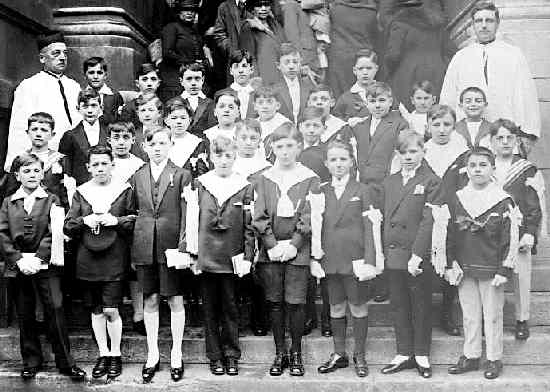
Figure 1.--These French boys have just taken there First Communion in 1926. Note the number of boys wearing sailor suits.


Figure 1.--These French boys have just taken there First Communion in 1926. Note the number of boys wearing sailor suits. |
A French reader has provided us this 1926 photograph of French boys with their priest outside the church after taking their First Comminion. He points out some details about the suits they are wearing.
Elle est la photo souvenir d'une «communion solennelle». Tous les garçons
ont 12 ans, l'âge pour ce rite catholique romain. Ils sont alignés sur le
parvis de l'église. A l'époque, pour cette célébration importante, souvent
au détriment de son budget, la famille offrait à l'enfant un beau costume de
cérémonie. Aujourd'hui, (depuis les années 50) le communiant est revêtu d'
une aube (un vêtement ecclésiastique simple) qui descend jusqu'aux chevilles
et dissimule l'éventuelle modestie du costume (ainsi tous les enfants sont
égaux, les pauvres comme les riches).
Sur cette photo de 1926, les garçons portent tous le brassard qui indique qu
'ils sont communiants. On remarque la diversité des types de costumes. Le
plus étonnant est la persistance des costumes «marins» avec le grand col
rabattu par dessus la veste. L'un des garçon porte même le béret marin dans
ses mains. Les autres portent des costumes plus civils (avec vestons droits
ou croisés ou de «fantaisie». Il est à remarquer que certains sont en
culottes courtes, d'autres en pantalons (culotte longue descendant jusqu'aux
cheville comme pour les adultes). Il faut savoir que, jusqu'en 1950/1960,
pour beaucoup de garçons, le jour de la communion solennelle était le
premier jour où ils quittaient la culotte courte et portaient un pantalon.
Ceci devait avoir une valeur symbolique, ils quittaient l'enfance pour
devenir «presque» adulte. Parmi ceux qui portent une cravate, beaucoup ont
un noeud papillon. Les cravates sont blanches, couleur de la pureté
nécessaire pour allé communier (ici sur la photo on distingue mal ces
cravates car les chemises sont blanche).
Un détail amusant: Au premier rang, en partant de la gauche, le 3e enfant porte une médaille accrochée à son revers. Cette médaille indique que c'est un bon écolier. C'
est une manie française de distribuer des médailles ici ou là. Cela se
faisait autrefois dans les écoles. Elle indique que le garçon est le premier
de sa classe. Mais attention, elle n'est pas acquise définitivement, il
fallait rester le premier pour la conserver.
This photograph was taken as souvenir for the boys taking "solemn communion" (First Communion). All the boys are 12 years old, the age for this Roman catholic rite. They are posed on the steps of the church. At the time, for this significant celebration, often to the detriment of the family budget, the child received a beautiful formal suit. Today, (since the 1950s) the communicant is covered with an alb (a simple clerical wear) which comes down to his ankles and covers the differences in dress (thus all the children are equal, the poor like the rich person).
On this 1926 photograph, the boys all wear the arm-band which indicates that they are communicants. One notices the diversity of the types of costumes. Most astonishing is the persistence of the "navy" costumes with the large collar folded back over the jacket. One of the boys has a navy cap in his its hands. The other boys waer civil costumes (with
single-breasted or crossed jackets or of "imagination". It is to be noticed that some
wear short trousers, others in trousers (long trousers going down to the ankles like adults). It should be known that, until 1950/1960, for much of boys, the day of the
solemn communion was the first day when many left short trousers and began wearing long trousers. This had an symbolic importance, they were leaving childhood to become "almost" adult. Among those which carry a tie, much have a bow tie. The ties are white, color of the purity necessary for communicant. (In the photograph it is difficulr to discern the ties because the shirts are white.)
An amusing detail: To the first row, from the left, the 3rd child carries a medal fixed on his lapel. [HBC note: Thius is the boy wearing a three-piece suit with white kbeesocks and court pumps.] This medal indicates that it is a good schoolboy. It is a French mania to distribute medals here or there. That was done formerly in the schools. It indicates that the boy is the first of his class. But note, the medal is not his permanently, he had to work hard to retain possession of it.
Navigate the Historic Boys' First Communion pages:
[Return to the Main French Inter-war First Communion page]
[Return to the Main First Communion page]
[Renewals]
[America]
[France]
[Spain]
[Switzerland]
Navigate the Historic Boys' Clothing Web Site:
[Introduction]
[Activities]
[Biographies]
[Chronology]
[Clothing styles]
[Countries]
[Bibliographies]
[Contributions]
[FAQs]
[Glossaries]
[Satellite sites]
[Tools]
[Boys' Clothing Home]
Navigate the Historic Boys' Clothing Web chronological pages:
[The 1920s]
[The 1930s]
[The 1940s]
[The 1950s]
[The 1960s]
[The 1970s]
Navigate the Historic Boys' Clothing Web style pages:
[Short pants suits]
[Blazers]
[Jackets]
[Kilts]
[Sailor suits]
[Sailor hats]
[Ring bearer/page costumes]
[Shortalls]
